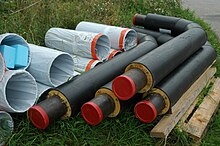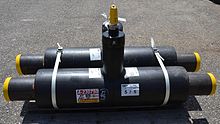Plastic jacket composite pipe

The plastic jacket composite pipe , KMR for short , is a pipe that is factory-fitted with thermal insulation for transporting hot media, especially water. Plastic jacket composite pipes are rarely used to transport cold-running media. Plastic jacket composite pipes are mainly installed in district heating networks and are usually laid directly in the ground. If many bends are required, as is often the case in local heating networks, flexible composite pipes are preferred.
System structure
The medium pipe is made of steel , the thermal insulation is made of rigid polyurethane foam and the jacket pipe is made of polyethylene . The jacket pipe protects the thermal insulation from external influences. The thermal insulation made of polyurethane foam bears the weight of the filled medium pipe and creates a force-fit connection between the medium pipe, thermal insulation and casing pipe. The force-fit connection absorbs the forces generated by the heating of the pipeline and diverts them into the ground.
Usual medium pipe dimensions are in the range from DN 15 to DN 1200, the pipes are usually delivered as bar goods in lengths of 6, 12 or 16 meters. Since it is a rigid pipe, preformed fittings are used for bends , which are also provided with thermal insulation and jacket pipe. Fittings are also available that are constructed like a plastic jacket composite pipe. Plastic jacket composite pipes are usually offered with three different thicknesses of thermal insulation, which results in three different outer pipe diameters for each inner pipe.
Leak monitoring system
Plastic jacketed composite pipes are often equipped with a monitoring system that responds to moisture in the thermal insulation. Two wires are usually embedded in the thermal insulation of the pipes, which are used for resistance and transit time measurement for pipe network monitoring and leak location. The "Nordic System" uses two bare copper wires, one of which is often tinned. The "resistance locating process" works with a partially insulated resistance wire made from a chrome-nickel alloy and a bare copper wire. If three wires are embedded, these are usually two bare copper wires, one of which may be tinned, and a partially insulated chrome-nickel wire, which can be used to implement either the Nordic system or the resistance location method. During the assembly of the pipes, the electrical conductors of the individual pipe segments are conductively connected to one another, at the end of a section diagnostic plugs with measuring devices for leak detection are fitted. Two systems are common for leak detection:
- Nordic system ( English Nordic system , also "Echoguard system") with a pulse reflection measurement method with high-frequency voltage pulses on two copper wires with 1.5 mm 2 each . The line impedance, which can be determined by diagnostic devices, changes due to leaks . The fault location can be determined from the transit times of the reflected wave at the fault location. Both copper wires are bare in this system, one of the two wires is additionally tinned.
- Brandes system with an ohmic resistance measurement with direct voltage. A wire with 0.5 mm 2 consists of the alloy chromium-nickel with a red insulation which is perforated at defined intervals and thus allows localization. The second wire is designed as a copper wire with 0.8 mm 2 and continuous green insulation.
Application limits
The medium pipe is usually designed for operating pressures of up to 1.6 MPa (16 bar, PN16), 2.5 MPa (25 bar, PN25) or less often 4.0 MPa (40 bar, PN40). The upper limit temperature for continuous operation is determined by the polyurethane foam and is approx. 140 ° C. In recent times there have been efforts to produce plastic jacket composite pipes with a higher permissible continuous operating temperature. Steel jacket pipes are used in pipe networks with temperatures that are above the permissible continuous operating temperature of plastic jacket composite pipes .
Designation of the plastic jacket pipes
In the case of plastic jacketed composite pipes, the jacket pipe dimension is specified in addition to the carrier pipe dimension. The specification DN 50/125 denotes a plastic jacket composite pipe with a carrier pipe with nominal dimension DN 50 (outside diameter 60.3 mm) and a jacket pipe with outside diameter 125 mm, which corresponds to the minimum required thickness (strength) of the thermal insulation. The specification DN 50/140 denotes a plastic jacket composite pipe with single reinforced thermal insulation, the specification DN 50/160 denotes a plastic jacket composite pipe with double reinforced thermal insulation.
standardization
In Europe, plastic jacket composite pipes are described in the following standards :
- EN 253 describes the pipe rods.
- EN 448 describes the fittings.
- EN 488 describes the fittings.
- EN 489 describes the pipe connections ("sleeves").
- EN 13941 describes calculation and laying methods for pipe networks made of plastic jacket composite pipes.
- EN 14419 describes the monitoring systems used in plastic jacket composite pipes.
laying
The individual rods and fittings are connected to one another on the construction site. The media pipe ends are welded together. The medium pipe sections that are exposed after welding are closed with a sleeve made of polyethylene, which was pushed over the end of the casing pipe before welding. The cavity in the socket is filled with polyurethane foam. The connection established in this way is also referred to as a joint as a whole.
In the area of bends and branches, the axial thermal expansion can cause high stresses. For this reason, expansion pads are placed on the outside and inside of bends and branches in order to provide the bends and branches with sufficient displacement when the temperature changes. The expansion pads are mounted on the pipeline before pre-tensioning.
The pipeline is usually thermally prestressed. The steel pipe is heated with warm water or electrically to about half the maximum operating temperature and expands around 750 mm per km. When the appropriate temperature is reached, the pipeline is completely backfilled with a sand that contains only a few cohesive components and covered with it at least 10 cm. In this context, the EN 489 standard mentions dry sand with a grain size range from 0 to 4 mm. In already sandy soils, such as Iceland, the plastic jacket composite pipe is also laid directly in the ground. This procedure does not correspond to the current European standardization. Current research projects are examining the laying of the plastic jacket composite pipes directly in (processed) excavated material, which would reduce the laying costs.
The necessary laying depth results from the pipe statics, among other things. Since the pipe expansion is absorbed by axial bracing, the pipeline must be sufficiently weighted by the weight of the earth so that it does not push itself out of the earth in the event of thermal expansion.
lifespan
Plastic jacketed composite pipes and sleeves are designed for a service life of at least 30 years. The oldest plastic jacketed composite pipes in operation are around 40 years old (as of 2009). After 30 years of operation, the requirements of EN 253 are mostly still met. Individual socket damage occurs continuously during the operating time, but can be found and spatially localized by leakage monitoring, which makes renovation easier.
Web links
- KMR dimensions, standardized according to EN 253 and therefore valid regardless of manufacturer (PDF; 404 kB)
Individual evidence
- ↑ Technical description of the PREMANT district heating pipe (as of April 15, 2010)
- ↑ Nordic System ( Memento of the original from March 23, 2010 in the Internet Archive ) Info: The archive link was inserted automatically and has not yet been checked. Please check the original and archive link according to the instructions and then remove this notice.
- ↑ Resistance location ( memento of the original from March 23, 2010 in the Internet Archive ) Info: The archive link was inserted automatically and has not yet been checked. Please check the original and archive link according to the instructions and then remove this notice.
- ↑ Archived copy ( Memento of the original from July 27, 2011 in the Internet Archive ) Info: The archive link was inserted automatically and has not yet been checked. Please check the original and archive link according to the instructions and then remove this notice. Photographic construction report of a district heating pipeline from EVN Wärme ; As of Sept. 11, 2010.
- ^ Andreas Oberhammer; The longest district heating pipeline in Austria ...., illustration on page 28; March 2010 ( Memento of the original from July 6, 2011 in the Internet Archive ) Info: The archive link was inserted automatically and has not yet been checked. Please check the original and archive link according to the instructions and then remove this notice. (PDF; 15.4 MB); As of April 2, 2010.
- ↑ ÖNORM EN 13491 Calculation and laying of plastic casing pipes.
- ↑ http: //www.fernwärme.de/Forschungsprojekte.html Remaining service life analysis on 30 year old plastic composite jacket pipes.
- ↑ Klaus Kott (PDF; 237 kB) KMR damage statistics from Stadtwerke Erfurt, page 119.






